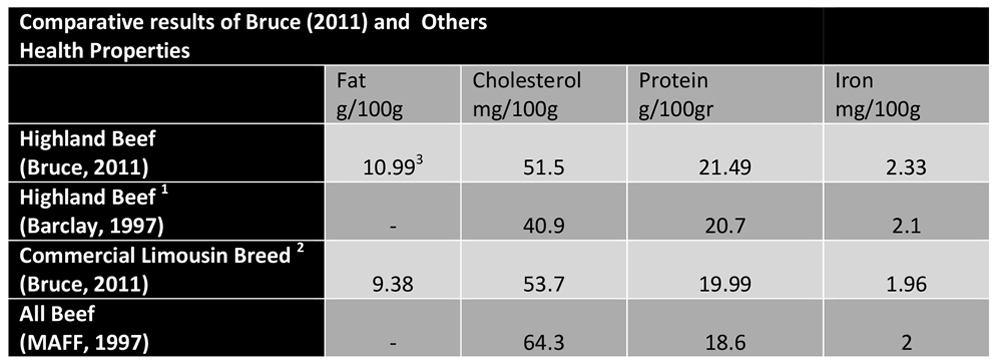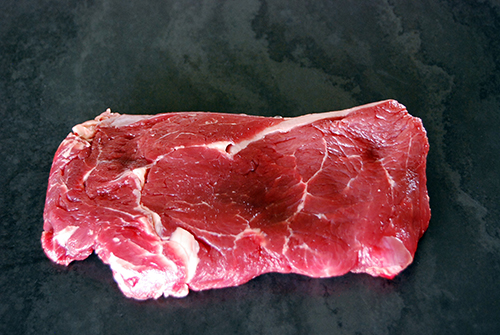The past years left us little scientific reference on the value of Highland beef. And yet ... the few comparative scientific studies on the subject and the small number of Highland carcasses enrolled in recognized competition have given us impressive results and interesting avenues to explore.
The Stroh family of Colorado won Grand Champion or Reserve Grand Champion, in at least one category of the "Hanging Beef Carcass" contest at the National Western Stock Show in Denver, for 22 out of the 25 years they entered.
Barclay Study
In 1997, Dr. Ivy Barclay of the Scottish Agricultural College conducted research which demonstrated the exceptional nutritional qualities of Highland beef (compared to other beef cattle of all breeds).
The results showed a significant difference; Highland beef was shown to be superior in iron, protein and tenderness.

Ivy Barclay, Head of the Food Science & Technology Department of the Scottish Agricultural College – Study published by the Ministry for Agriculture Fisheries and Food (MAFF)
1. Results from the All Beef study published by McCance & Widdowson of the Ministry for Agriculture Fisheries and Food (MAFF)
Bruce Study
The table below is a summary of the research of Bruce. We thank Dr. Charles J. Bruce and the Highland Cattle Society for sharing this research data. Contact the secretary of Highland Cattle Society if you wish to request the full report.

1. Different measures were used in the previous studies (All Beef & Barclay) that made the comparison irrelevant. The All Beef & Barclay (1997) studies used total fat measure while Bruce (2011) used intramuscular fat.
2. The Limousin breed was chosen by Bruce as it is the most common terminal breed in the UK beef industry.
3. Bruce mentioned that having a higher level of fat is not necessarily negative since the intramuscular fat (marbling) is what gives the succulence and flavour to the beef.
RESULTS ANALYSIS:
Protein: The results show that the protein levels of the Highland beef are in average 1.5g/100g or 6.98% higher than the commercial Limousin breed samples. The T Test showed that the results were statistically significant. (Test that compares 2 average measurements or groups in order to determinate if the difference is significant.)
Iron: The results show that the iron percentage of the Highland beef are in average 0.33mg/100g or 15.88 % higher than the commercial Limousin Breed samples. The T Test showed that the results were statistically significant. (Test that compares 2 average measurements or groups in order to determinate if the difference is significant.)
Cholesterol: The results show that the cholesterol levels of the Highland Beef are in average 2.2mg/100g or 4.1% 1.5g/100g lower than the commercial Limousin Breed samples. The T Test showed that the results were not statistically significant. (Test that compares 2 average measurements or groups in order to determinate if the difference is significant.)
Intramuscular Fat: The results show that the Intramuscular Fat levels of the Highland Beef are in average 1.61g/100g or 14.65% higher than the Commercial Limousin Breed samples. The T Test showed that the results were not statistically significant. (Test that compares 2 average measurements or groups in order to determinate if the difference is significant.)

1. Breed selected by Bruce as it is the most common terminal breed in the UK beef industry.
RESULTS ANALYSIS:
Tenderness: The results from the sheer slice force test show an average difference of 24.57 or 22.78% between the Highland beef and the commercial Limousin Breed samples. The T Test showed that the results were statistically significant. (Test that compares 2 average measurements or groups in order to determinate if the difference is significant.)
A result lower than 100 is considered to be very tender and superior to 200, as being very tough. Therefore, it is correct to say that the Highland beef scores very well in terms of tenderness.
Other Research
J. Hunt ‘s article – Farmers weekly Interactive, Bristol University (I. Richardson)
This recent research compared the differences between slow grown native breeds and Charolais commercial type beef. The results indicate a higher rate of polyunsaturated fat in the native breeds which are reared for a longer period of time in a natural environment. Therefore, less fat is deposited and a longer period of time allows for the Omega 3 type fatty acids to reach higher levels of concentration.
Closer to us, the American Highland Cattle Association ( AHCA ) is currently collaborating on a major national study on the nutritional value of Highland beef with University of Missouri Meat Science graduate students, under the direction of Dr. Bryon Wiegand . We eagerly await the results of this new research which will soon be released. For those interested in following the evolution of this study, you can visit the AHCA web site.
Maintaining of the purity of the Highland breed over the centuries and the concern of farmers to preserve the natural characteristics of the breed certainly contribute to the high quality of Highland beef. Highlands and their crosses have the ability to produce a quality meat product without the excessive external fat of other breeds.
The consumer’s growing interest and demand for natural beef makes the Highland breed a very interesting option, especially for farmers who want to use their pastures to produce quality grass-fed beef.


